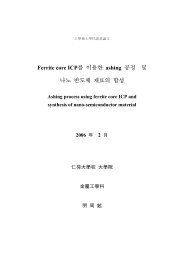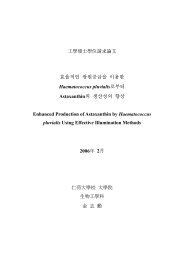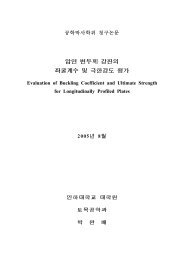저작자표시-비영리-변경금지 2.0 대한민국 이용자는 아래의 조건을 ...
저작자표시-비영리-변경금지 2.0 대한민국 이용자는 아래의 조건을 ...
저작자표시-비영리-변경금지 2.0 대한민국 이용자는 아래의 조건을 ...
You also want an ePaper? Increase the reach of your titles
YUMPU automatically turns print PDFs into web optimized ePapers that Google loves.
vacuo at 60 ºC for 6 h to remove any residual H2O. For solution<br />
blending, PBS pellets were dissolved and stirred in chloroform at 40 ºC<br />
for 5 h using mechanical stirrer. Also, CNFs were dispersed in same<br />
solvent at room temperature for 3 h with spin-bar and then sonicated<br />
for 2 h at 90 W by a ultrasonic bath (Kodo Technical Research Co.,<br />
Japan). After CNFs solution was mixed with PBS solution at 40 ºC for<br />
24 h under vigorous shear condition, nanocomposite casting films were<br />
obtained on rotary hood, and additionally dried at 60 ºC for 24 h to<br />
remove a solvent. For the melt blending, the torque rheometer<br />
(Brabender Plastograph EC, Germany) was used to prepare the PBS<br />
nanocomposite based on a various content of CNFs. The PBS pellets<br />
was melted at 120 ºC for 5 min at a rotary speed of 60 rpm, and then<br />
CNFs were introduced into the mixer, followed by compounding for 10<br />
min. For the SOAM method, the casting films prepared by the solution<br />
blending were firstly cut into the specific size, and then fed into the<br />
torque rheometer and mixed at 120 ºC for 10 min at a rotary speed of<br />
60 rpm. The mass fraction of CNFs ranged from 0.1 to 3 wt%. The<br />
sample codes were named, for example, CNF2S, CNF2M and<br />
CNF2SM, where the numbers represent the mass fraction of CNFs,<br />
30







